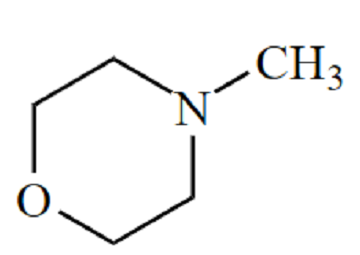English Synonyms
NMM;N-Methyl morphofine;N-METHYLMORPHOLINE;4-METHYL-1-OXA-4-AZACYCLOHEXANE;4-METHYLMORPHOLINE;AKOS 89985;LUPRAGEN(R) N 105;1-Methylmorpholine
N-Methylmorpholine Properties
| Melting Point | −66 °C(lit.) |
| Boiling Point | 115-116 °C750 mm Hg(lit.) |
| Density | 0.92 g/mL at 25 °C(lit.) |
| Vapor Density | >1 (vs air) |
| Vapor Pressure | 18 mm Hg ( 20 °C) |
| Refractive Index | n20/D 1.435(lit.) |
| Flash Point | 75 °F |
| Storage Condition | Store Below +30°C. |
| Solubility | Soluble in Chloroform, Ethyl Acetate, Methanol (Trace Amount) |
| Form | Liquid |
| Acidity Coefficient (pKa) | 7.38(at 25℃) |
| Color | Transparent |
| PH | 10.6 (50g/l, H2O, 20℃) |
| Water Solubility | >500 g/L (20 ºC) |
| Stability | Volatile |
Usage and Synthesis of N-Methylmorpholine
Introduction
N-Methylmorpholine Is an Important Organic Chemical Intermediate. It Is an Excellent Solvent, Emulsifier, Corrosion Inhibitor, Polyurethane Foam Catalyst, And Can Also Be Used as a Pesticide Intermediate. Its Synthesis Methods Mainly Include N-Methylation Method Using Morpholine as Raw Material, Cyclization Method Using Diethanolamine as Raw Material, Cyclization Method Using Diethanolamine as Raw Material, And Synthesis Method Using Dichloroethane as Raw Material.
Application
N-Methylmorpholine Is a Heterocyclic Tertiary Amine and an Important Fine Chemical Raw Material. It Can Be Used as a Catalyst for the Production of Polyurethane Foam, A Catalyst for Pharmaceutical Synthesis and Organic Synthesis, And Can Also Be Used to Synthesize Fine Chemical Products Such as Medicines, Pesticides, Surfactants, Emulsifiers, Corrosion Inhibitors, Etc. It Can Also Be Used as a Solvent, Extractant and Curing Agent for Polyurethane Coatings.
As an Organic Chemical Intermediate, N-Methylmorpholine Has the Dual Properties of Tertiary Amine and Ether. It Can Be Used as a Surfactant, Extractant, Corrosion Inhibitor, And Is Also Widely Used in the Fields of Pesticides and Medicine. N-Methylmorpholine Is a Heterocyclic Tertiary Amine with the Properties of Ether and Amine. It Is Widely Used in the Synthesis of Pesticide Compounds Such as Insecticides, Fungicides, And Plant Growth Regulators. It Is Also Used in the Synthesis of Fine Chemical Products Such as Surfactants, Lubricating Oil Coolants, Metal Rust Inhibitors, And Fiber Treatment Agents.
Preparation
87g of Morpholine Was Added to a 250ml Three-Necked Flask with a Reflux Condenser and an Electric Stirrer. When Heated to 100°c, A Mixture of 57.7g of Sodium Dihydrogen Phosphite and 36g of Paraformaldehyde Was Added While Stirring. Reflux Occurred When the Temperature Reached 115°c. The Temperature Was Maintained for 20 Minutes, And Then Cooled. Sodium Hydrogen Phosphate Crystallized in the Form of Water and Solid. The Solid Was Separated by Filtration to Obtain the Filtrate as the Product. The Filtrate Was Directly Distilled Without Drying. The Fraction at 114-117°c Was Collected to Obtain 95g of N-Methylmorpholine, And the Purity Was 98% as Analyzed by Gas Chromatography.
Use
N-Methylmorpholine Is Used as Solvent, Catalyst, Emulsifier, Organic Synthesis Intermediate, Etc.
Used in Organic Synthesis and Pharmaceutical Industry, Also Used as Gas Chromatography Stationary Liquid.
Pharmaceuticals and Chemical Synthesis Media, Organic Synthesis Raw Materials, Analytical Reagents, Extraction Solvents, Stabilizers for Chlorocarbons, Corrosion Inhibitors, Catalysts, Drug Production, Etc.
Nmm Is Soluble in Water, Alcohol, And Ether. It Can Be Used as a Solvent for Rayon, A Corrosion Inhibitor, And in the Synthesis of Rubber Accelerators and Other Fine Chemicals. It Is Also Used as a Polyurethane Catalyst and a Catalyst for the Synthesis of Aminobenzylpenicillin and Hydroxypenicillin. N-Methyl Morpholine Oxide Can Be Produced by Double Oxidation.
N-Methylmorpholine (Nmm) Is Used as a Catalyst, Extractant, Stabilizer for Chlorocarbons, Corrosion Inhibitor, Analytical Reagent and in Pharmaceutical Manufacturing.
Production Method
Obtained by the Reaction of Morpholine with Formaldehyde and Formic Acid. Slowly Add Formaldehyde to Morpholine, Add Formic Acid Dropwise While Stirring, The Reaction Will Automatically Reflux and Release Carbon Dioxide. After Adding Formic Acid, Heat and Reflux for 4-5h. After Cooling, Add Sodium Hydroxide and Distill Immediately, Collect All Fractions Below 99℃, Add Sodium Hydroxide to Saturation, Cool to Separate the Oil Layer, Dry, Fractionate, Collect the Fraction of 114.5-117℃, Which Is N-Methylmorpholine. Another Method Uses Dichloroethyl Ether, Monomethylamine Aqueous Solution, Liquid Alkali and Other Raw Materials for One-Step Synthesis, With Short Process, Simple Equipment, Mild Process Conditions, Less Investment, High Product Yield and Good Quality.
The Preparation Method Is to Slowly Add Formaldehyde to Morpholine, Add Formic Acid Under Stirring to React, Automatically Reflux, And Release Carbon Dioxide. After Adding Formic Acid, Heat and Reflux for 4 to 5 Hours, Add Sodium Hydroxide After Cooling and Immediately Distill, Collect All the Fractions Before the Boiling Point of 99°c, Then Add Sodium Hydroxide to the Fraction Until Saturated, Cool to Separate the Oil Layer, Dry, And Fractionate to Obtain N-Methylmorpholine.
Category
Flammable Liquids
Toxicity Classification
Poisoning
Storage and Transportation Characteristics
The Warehouse Is Ventilated, Low Temperature and Dry; Stored Separately from Oxidants and Acids


